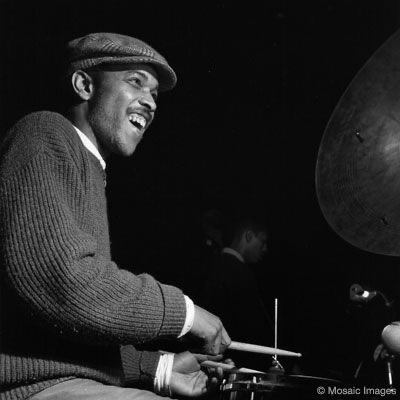Dive into the Power & Passion of ‘Tenor Madness
In the vast panorama of jazz, Sonny Rollins’ “Tenor…
A rhythmic genius, Billy Higgins, shaped the face of modern jazz drumming. His delicate touch and unparalleled swing carried his artistry across generations, leaving a legacy that continues to inspire drummers worldwide.

Born on October 11, 1936, in Los Angeles, California, Billy Higgins grew up surrounded by the sounds of bebop, gospel, and rhythm and blues. The drums piqued his curiosity, providing the perfect outlet to express himself musically. Influenced by the likes of Max Roach, Philly Joe Jones, and Art Blakey, Higgins honed his skills, playing with passion and inventiveness.

As a teenager, Higgins played with local bands, quickly gaining a reputation for his impeccable timing and nuanced playing. His high school years provided ample opportunities for him to explore different styles, and it wasn’t long before he decided to pursue a professional career in music. At the tender age of 19, he joined the legendary Ornette Coleman‘s group, kickstarting a remarkable journey in the jazz world.
Higgins’ early professional years saw him collaborating with the leading jazz musicians of the time. A notable example is Herbie Hancock‘s groundbreaking debut album, “Takin’ Off”. Higgins’ drumming on this album is a study in subtlety, deftly supporting the band while simultaneously propelling the music forward. His synergy with the ensemble, which included Hancock on piano, Freddie Hubbard on trumpet, and Dexter Gordon on tenor saxophone, demonstrated his ability to adapt to a variety of musical settings.
Another classic in his discography is Eric Dolphy‘s “Out to Lunch”, where his masterful drumming navigated the complex compositions of this avant-garde masterpiece. Recorded with a stellar lineup featuring Dolphy on alto saxophone and bass clarinet, Freddie Hubbard on trumpet, Bobby Hutcherson on vibes, and Richard Davis on bass, Higgins’ contributions provided the rhythmic backbone, adding depth and texture to Dolphy’s ambitious vision.
In Lee Morgan‘s “The Sidewinder”, Higgins’ drumming was integral to the album’s success. The title track became an instant hit, with Higgins laying down an infectious groove that complemented the catchy melody. Morgan’s hard bop quintet, consisting of Joe Henderson on tenor saxophone, Barry Harris on piano, and Bob Cranshaw on bass, was elevated by Higgins’ impeccable timekeeping and tasteful playing.
Higgins’ collaboration with Lee Morgan continued in “Search for the New Land” (1964), an album that explored the boundaries of hard bop. Alongside Morgan, Herbie Hancock on piano, Wayne Shorter on tenor saxophone, Grant Green on guitar, and Reggie Workman on bass, Higgins deftly navigated the intricate arrangements and shifting time signatures, adding a sense of stability and flow to the music.
Hank Mobley‘s “The Turnaround” showcased Higgins’ ability to drive the music with his distinctive swing. Paired with Mobley’s soulful tenor saxophone, Herbie Hancock on piano, Donald Byrd on trumpet, and Paul Chambers on bass, Higgins’ rhythmic vocabulary and dynamic control contributed to the album’s groovy and infectious sound.
In Jackie McLean‘s “A Fickle Sonance“, Higgins’ drumming shone alongside the alto saxophonist’s fiery improvisations. Supported by Tommy Turrentine on trumpet, Sonny Clark on piano, and Butch Warren on bass, Higgins’ playing demonstrated his versatility as he traversed the spectrum from delicate brushwork to assertive rhythmic punctuations.
Dexter Gordon‘s “Go” and “Gettin’ Around” both feature Higgins’ distinctive touch and signature swing. In “Go,” he joined forces with Gordon on tenor saxophone, Sonny Clark on piano, and Butch Warren on bass. His sensitive, yet driving, approach to the drums provided the perfect accompaniment to Gordon’s rich tenor sound. Similarly, in “Gettin’ Around,” Higgins’ drumming perfectly complemented the band, which included Gordon, Bobby Hutcherson on vibes, Barry Harris on piano, and Bob Cranshaw on bass. His playing, a delicate balance between assertiveness and restraint, brought out the best in his fellow musicians.
Donald Byrd‘s “Royal Flush” saw Higgins lending his rhythmic prowess to an album that pushed the boundaries of hard bop. With Byrd on trumpet, Pepper Adams on baritone saxophone, Herbie Hancock on piano, and Butch Warren on bass, Higgins contributed his trademark swing and precise timekeeping, elevating the group’s sound to new heights.
Billy Higgins’ middle age years were marked by continued growth and exploration. His playing remained influential, and he continued to record with both established jazz giants and emerging talents. Through the years, his music evolved, reflecting his willingness to adapt to new styles and ideas.

In his later years, Higgins became a revered figure in the jazz community, collaborating with numerous musicians across generations. His impact on the music was evident not just through his recordings but also in the countless drummers he mentored and inspired. As his music evolved, so too did his status as a living legend.
Sadly, Billy Higgins passed away on May 3, 2001, leaving an indelible mark on the jazz world. His death was mourned by fans and musicians alike, who recognized the tremendous influence he had on the art form. The jazz community has never forgotten his contributions, and his legacy continues to inspire new generations of artists.
Today, Billy Higgins is remembered as a pioneer in jazz drumming, whose innovative approach to rhythm has left an indelible mark on the music. Many of today’s jazz artists have been influenced by his work, both in terms of his drumming style and his unwavering commitment to the art form.
In conclusion, Billy Higgins’ contributions to the world of jazz drumming cannot be overstated. His unique style, impeccable timing, and infectious swing have left an indelible mark on the genre, inspiring countless musicians to push the boundaries of their own playing. As we celebrate his life and work, we can appreciate the lasting impact he has had on the jazz community and the countless artists who have followed in his footsteps.